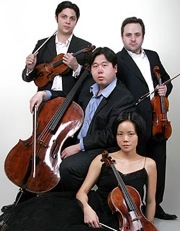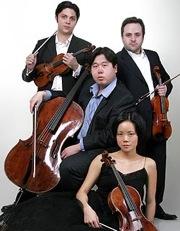
If the Hausmann Quartet is playing the usual game, they’ve gone about it with more than usual subtlety. The ensemble’s recital Sunday afternoon at San Francisco’s Old First Church (under the auspices of Old First Concerts) bracketed a piece well off the beaten path with two works by familiar and much-loved composers, true. But it’s a highly optimistic strategist who would dangle Alexander von Zemlinsky’s 1924 Third Quartet as a lure for the cognoscenti. Granted, for some people that lure would be irresistible (as it was for me). Still, we aren’t usually the people by whom anyone’s reputations are made.
Zemlinsky — who was Schoenberg’s teacher and, later, his brother-in-law — is rarely performed here. It may have something to do with his own equivocal career, where the fame of Schoenberg so overtook his own that by the mid-1920s (when the Third Quartet was written) one chunk of the potential audience hated his music because it wasn’t tonal, while another chunk hated it because it wasn’t serial.
The actual harmonic language of the piece is eerily like early Alban Berg. The first couple of minutes of the Zemlinsky so closely echo Berg’s Op. 3 Quartet, from 15 years before, that I can’t help but think it was deliberate. Yet Zemlinsky liked things tauter and tidier than the Berg of Op. 3 did.
The second movement is a theme and variations, with a difference. The theme is just a set of whiffs, a collection of fleeting gestures. It’s the variations that put flesh to what isn’t originally anything so substantial even as bones. There’s a headily fragrant sort-of-chorale in there that it’s almost impossible to relate to the wispy opening unless you force yourself to remember the “theme.” Then ... “Ah, got it.”
The slow movement proper is of another kind. It has a steady tread, and chords that you expect to resolve cleanly but that never do until the very end. And the finale is a “Burleske,” full of antics for the individual players (Angela Choong's agile viola in the lead). It ends ostentatiously on a unison C, as though to say, “This is so tonal, and I defy you to prove otherwise.”
Cheers for the Hausmann Quartet for programming this work. And for playing the hell out of it. This isn’t easy music to get inside, but nothing Sunday sounded hesitant or even slightly off the mark. And learning it as well as this is a considerable investment for a young ensemble.
Summoning a Dream
The Zemlinsky alone made this a highly unusual program, though neither of its companion pieces is exactly common currency, either. Ordinarily, a Haydn quartet with a nickname fares much better than one without in the programming sweepstakes, but “The Dream” (Op. 50/5) seldom shows up, even by Haydn standards. I can’t think why; there is vintage comic Haydn, replete with feints and rhythmic tricks, in all three of the fast movements, while the eponymous slow movement, with its mysteriously undulating harmonies, is among the composer’s best.The Hausmanns play lithe and brilliant, if rather brisk, Haydn. The first movement was too fast for comfort — not the quartet’s (the many runs of sixteenth-note triplets were sparkling clean), but mine. The intimate byplay in the piece doesn’t quite work at that speed; there isn’t enough time for players even to seem to react to one another, and so passages that can feel like conversation sounded more like rote exchange of material.
In the Menuetto, also, there was something too pat about the second strain’s wild violin canon and the subsequent discombobulation. (The violins chase themselves a beat apart until the original meter is hopelessly lost, and the section ends “in two,” though the music is written “in three” throughout.) So much of the vitality of Haydn consists in his — and the players’ — pulling against the background fabric of the piece in such a way that it stretches but doesn’t tear. You have to feel the original warp and woof even as they’re being distorted; the “three” has to be audible somehow behind the “two.”
That said, the “Dream” itself was lovely. The Hausmanns played with effortless flow and blend, not to mention a fine appreciation of those waves of harmonic tension-and-release from which the movement is built. To top it off, the finale was magnificent — beginning with first violinist Isaac Allen’s readiness to slide (as the notation practically prods you to do) in the main theme, and continuing with another round of spectacularly neat passagework from all four players.
Antonin Dvořák’s A-flat Major Quartet, Op. 105, is another piece rarer on programs than you might assume (though happily in the Alexander Quartet’s ongoing Dvořák cycle there’s another chance to hear it next month). Op. 105 isn’t anything like as intimidating as its companion piece, the harmonically alarming Op. 106. Still, it has its involved moments, and I’ve wondered occasionally how many quartets were put off investigating it merely by opening the score to the first page and seeing the seven flats in the key signature. (The opening is in A-flat minor, a key that barely exists outside of textbooks.)
We had had the Hausmanns in 18th-century music, and then in 20th-century music. Here they were in late-19th-century music, and obviously enjoying themselves to the hilt. It takes some discretion to enjoy this music without seeming to wallow, particularly in a space like Old First Church, where you have to project like an old-school actor to be heard everywhere. But the Hausmanns’ Op. 105 seemed entirely natural, never overprojected; and even Yuan Zhang’s cello was sonorous and distinct in the notoriously cello-hostile space. The violins (Allen and Bram Goldstein) danced with quicksilver dexterity in the Scherzo.

